A Witness in the Cab
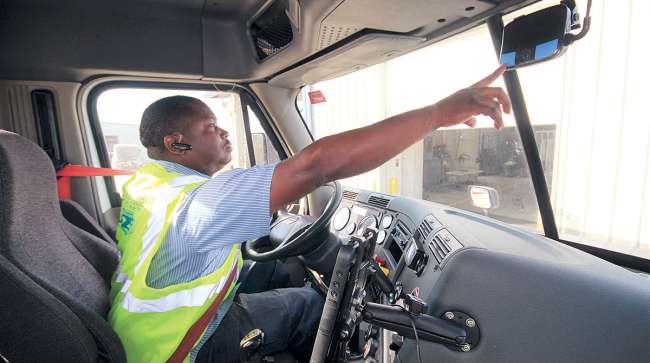
[Stay on top of transportation news: Get TTNews in your inbox.]
The use of onboard video systems in the trucking industry has expanded considerably in the past five years, with fleets installing cameras on their vehicles to reduce liability, exonerate drivers, cut insurance costs and enable customized driver coaching.
“Knowledge is power, even if it isn’t the knowledge you want,” said Jeremy Stickling, chief administrative officer for truckload carrier Nussbaum Transportation.

Stickling
As a growing number of trucking companies have embraced that perspective, cameras have become an increasingly common sight in truck cabs.
In 2014, fleets had onboard video subscriptions covering about 300,000 trucks, said Bart De Muynck, a research vice president at Gartner. That figure has grown to about 1.2 million today and is expected is to reach 1.3 million to 1.5 million in 2021.
To meet this demand, technology suppliers have introduced a broad variety of video options, ranging from basic dashcams to sophisticated video-based safety systems and analytics platforms. Some systems utilize only forward-facing cameras that record the road ahead,
While others also offer a driver-facing camera as well as other cameras around the vehicle to capture side and rear views.
Several years ago, only a few telematics vendors had video offerings, but now a majority of them have added video capabilities of their own, De Muynck said.
North America is the biggest market for video technology, which De Muynck attributes to an increased focus on safety as well as high insurance costs and large payouts by U.S. courts.
“That incentivizes people to use safety systems not just to make their systems and fleets safer, but to use data and go to insurance companies and negotiate those rates down,” he said.
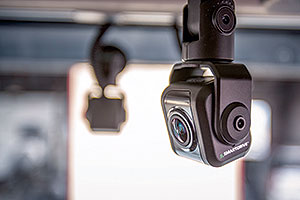
Vendors such as SmartDrive offer an array of hardware options, including road-facing, driver-facing, side and rear cameras. (SmartDrive Systems)
Nussbaum, based in Hudson, Ill., installed video systems from SmartDrive in 2014 and uses the technology to record critical events.
“If there is a collision, law enforcement doesn’t have to rely on witness statements that aren’t always very accurate,” Stickling said, adding that the fleet can send video to officers while they’re still on the scene.
Sometimes just the presence of a camera can benefit drivers.
“Law enforcement is more likely to believe our driver’s story when they make out the report when they know we have the camera,” Stickling said.
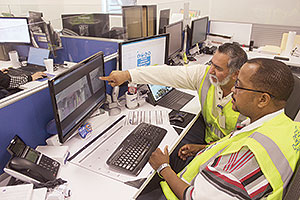
Stafford Wilson (right), a driver advocate at jetco Delivety, reviews camera footage with professional driver Roberto Gonzalez. (Jetco Delivery)
If fleets have enough trucks and enough drivers, at some point they will catch a driver doing something wrong, but using cameras will make the whole fleet safer, said Brian Fielkow, CEO of Jetco Delivery, a motor carrier based in Houston.
In the event of an accident, video can help provide clarity.
“Even if your driver is at fault, you want to know the facts,” he said. “You’re better off trying to figure out how to settle it, but for every one of those I’ve had, I’ve had many more where we’re able to show the camera video and kill the possibility of the claim,” he said.
In at least 75% of fatal crashes involving commercial trucks and passenger vehicles, the passenger-car driver is found to be at fault, so exoneration of the truck driver is probable, not just possible, said Mark Schedler, senior editor in transport management at J.J. Keller & Associates, a provider of fleet safety and regulatory compliance services that recently launched its own dash camera product.
Video could help a carrier avoid a multimillion-dollar verdict, he said, noting that the Federal Motor Carrier Safety Administration estimates that the average accident costs $91,000, the average injury cost from accidents is $334,892, and the average fatal accident settlement is $7.2 million.
Before the advent of in-cab video, trucking companies didn’t always have enough information to refute the other party’s claim, said Del Lisk, vice president of safety services for Lytx.
“Now they can change the blame from themselves to the other party,” he said, adding that even if a fleet’s driver is at fault in a crash, the carrier can avoid the investigation phase and move on to the settlement phase.
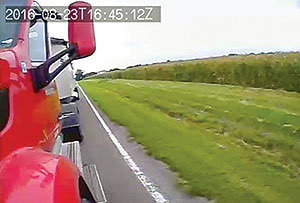
Trimble offers side cameras to capture a more complex view of the truck's surroundings. (Trimble)
Truck drivers typically aren’t at fault, said Jim Angel, vice president of video intelligence solutions for transportation technology supplier Trimble.
“Statistics show us our drivers are not at fault 80% of the time in collisions,” and over time, the use of video also can chip away at the remaining 20%, he said.
“More and more drivers want it in their truck to exonerate them,” Angel said. “They know they are the better driver most of the time.”
Most importantly, fleets that invest in technology typically see an overall improvement in safety, J.J. Keller’s Schedler said.
“A study of over 10,000 crashes by the Virginia Tech Transportation Institute found that event-based video systems, combined with driver-behavior coaching, reduced fatal crashes by 20% and reduced injury crashes by 35%,” he said.
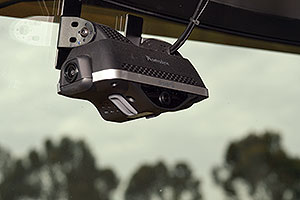
Netradyne's Driveri vision-based safety system can recognize road signs to help ensure drivers don't run stop signs. (Netradyne)
Stickling said Nussbaum’s most significant indicator for the value of video is loss ratio and insurance renewals.
“The insurance world is very tough. It seems like every day you’re reading about a nuclear settlement somewhere,” he said, adding that despite that, Nussbaum is experiencing some of its best insurance rates in the midst of a hard insurance market.
Fleets also can start capturing and analyzing the entire day rather than just a brief segment of video when a triggering event occurs, said Adam Kahn, president of fleet business at Netradyne, another supplier of onboard video technology.

Kahn
That full recording can show that a fleet’s drivers are operating safely at all times.
Some litigators targeting the trucking industry are going after fleets’ overall safety programs rather than a single action, Kahn said.
Netradyne’s Driveri system captures and analyzes every minute, he said. “A byproduct is I know what my driver was doing every day.”
Customizing Driver Coaching
Most fleets initially invest in technology because they want to address safety-related problems such as rising claims or more frequent collisions, said Steve Mitgang, CEO at SmartDrive.
“That is the starting point. I think we tend to attract customers who absolutely want to see more after that. They know we’ll be able to help them create new ideas and value down the road,” he said.
Nussbaum uses data from SmartDrive to support a behavior-based coaching program.
“The coaching isn’t on tickets or accidents anymore. It is on how you drive your truck,” Stickling said.
Jetco installed video systems from Lytx in 2015 to improve driver coaching.
“We made it really clear that in most cases, this was to help the drivers review the game tape. Every one of us is capable of being better and continuously improving,” Fielkow said, adding that the fleet also uses the video to praise drivers who demonstrate exemplary behavior.
Timely coaching based on video events not only improves driver behavior but also minimizes the impact of litigation and helps carriers avoid a finding of negligence by helping to uphold the carrier’s “duty to act,” a primary consideration for a jury large settlement, J.J. Keller’s Schedler said.
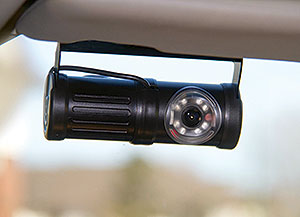
MiX Telematics' onboard technology issues audible alerts to give drivers an opportunity to correct unsafe behavior before triggering a recording. (MiX Telematics)
Brian McCoy, vice president at MiX Telematics, said video makes training more effective because managers can use actual examples rather than hypothetical situations.
“We often see unsafe driving behaviors curbed just by having the cameras in place, as drivers know that managers are alerted to triggers such as hard braking,” he said. “The video clips are essential for driver training, which also contributes to safety improvements.”
Personalized coaching resonates more than generic coaching, said Eleanor Horowitz, team lead for product marketing at Samsara, another technology provider that offers onboard video.
“We find the coaching ends up being more consistent,” she said. “For any event, we’re automatically adding labels like harsh braking, harsh turns or distracted driving.”
Coaching also aids in mitigating litigation.
“When you’re asked, ‘Have you talked to the driver, coached the driver and tried to change their behavior?’, now you have that on a monthly basis,” Kahn said.
With some video systems, drivers can utilize in-cab voice coaching for immediate feedback.
“Drivers can turn that on to hear if there is speeding or a harsh braking event. It clues someone into behavior they might want to change,” Samsara’s Horowitz said.
MiX Telematics’ electronic logging devices notify drivers audibly when an event is close to being triggered so they have the chance to correct an unsafe behavior beforehand, McCoy said. He added that MiX recommends that companies have clear policies on when they’ll view video and how they will use it and store it.
“Most fleets today only view video clips when an event is triggered. Everything else is discarded after 72 hours,” he said.
Improving Driver Management
Video technology can streamline the day-to-day management of drivers’ performance because they can take action based on alerts, said Mathew Long of Verizon Connect.
Operations managers and business owners can look at recordings to determine the facts if an incident occurs.
J.J. Keller’s Schedler said carriers must have a systematic process to monitor the data.
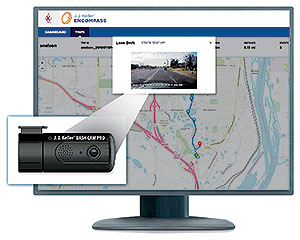
J.J. Keller has added a dash camera and video management tools to its line of safety and compliance systems. (J.J. Keller & Associates)
“An alert system alone will cause people to ignore many other significant trends that are costing the company or increasing risk. The goal initially is to have a few baseline reports and alerts that help identify the most significant risk and compliance issues,” he said.
SmartDrive’s Mitgang said data and analytics are all about actionable insights. In one study, SmartDrive found that in 85% of harsh braking events, only 15% were unsafe.
“You can have a lot of data, but if you don’t have a way to help the fleet take useful actions, it isn’t effective,” he said, adding that it is important to remove the noise and false positives. “If you’re going to take action with the driver, it better be right, or else you’re going to lose confidence.”
SmartDrive’s video system is designed to analyze a range of situations.
“If you’re driving through the rain, computer vision isn’t going to understand you’re going too fast,” Mitgang said. “We’re taking complex data combined together to give a very accurate picture of risk. Then we are effectively taking action.”
Similarly, data alone might suggest a risky maneuver even if a driver was doing everything right and avoided a collision, such as if a passenger vehicle pulls in front of the driver. That is why analysis is so essential, Mitgang said.
SmartDrive is focused on giving fleets what matters because they don’t have time to sort through all of the available videos, he said.
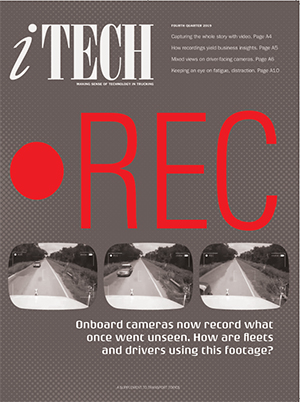
Fourth Quarter iTECH
- A Witness in the Cab
- Some Fleets Reluctant to Add Driver-Facing Cameras
- Analysis of Onboard Video Can Yield Operational Insights
- Self-Driving Trucks and Presidential Politics
- Driver Training, Monitoring Could Help Ensure Safe Testing, Deployment of Automated Trucks
- In-Cab Monitoring Uses Machine Vision to Detect Fatigued, Distracted Driving
Kahn said Netradyne’s Driveri looks at event causality and applies reasoning.
“A pedestrian in a crosswalk is a good reason to hard brake,” he said.
Data can allow fleets to identify driver patterns and coach them accordingly, said Jai Ranganathan, vice president of products at KeepTruckin, an ELD provider that also has introduced a dash camera.
KeepTruckin offers a workflow program that provides feedback to the driver, and drivers can log into an app to see their safety scores and access opportunities for self-coaching.
Ranganathan agreed that adding context makes video data more actionable.
“A lot of close following happens because cars cut in front of a truck,” he said. “It isn’t useful to show a safety problem when the truck driver couldn’t do anything about it. We add context with machine learning and human reviews.”
Some fleets use safety scores as a way to reward drivers or create a gamification program.
“Instead of punishing bad behavior, we see it encourage good behavior,” Samsara’s Horowitz said. “Drivers can see their own safety score and see how they rank against their peers.”
Netradyne has a mobile app connected to its system and shares data directly with drivers.
“Their score changes during the day. If they have two hours of great driving, their score goes up, and they feel a bump of appreciation,” Kahn said.
KeepTruckin’s Ranganathan said customers often report safety improvements right away.
“They will say within four months, they saw a 70% reduction in hard braking and rapid acceleration,” he said.
Lytx also monitors the effectiveness of each driver coach.
“Coaching sounds like an easy thing. Some people are very suited to it. Others never really learn how to do it,” Lisk said.
Data allows fleets and coaches to improve their operational efficiency by targeting the most serious safety risks.
“About 10% to 15% of drivers represent 55% to 60% of the risk. In that way, you’re using the time most efficiently and using it in the largest area,” Trimble’s Angel said. ³
Want more news? Listen to today's daily briefing:

